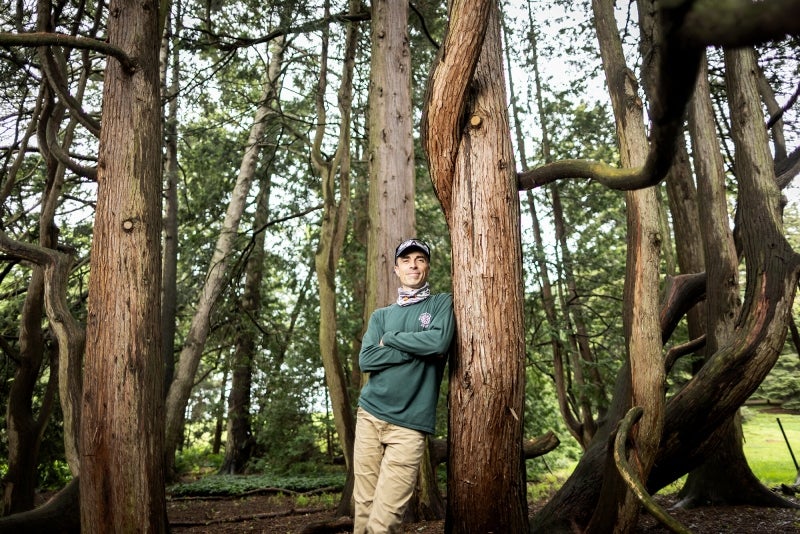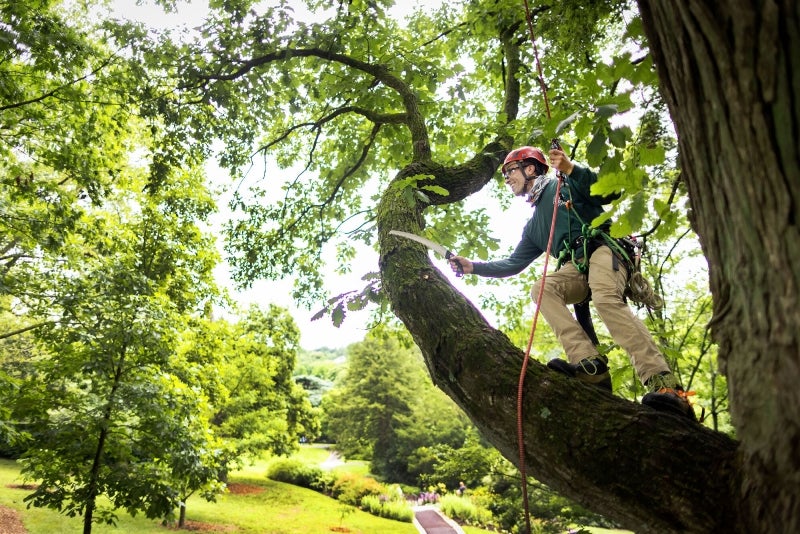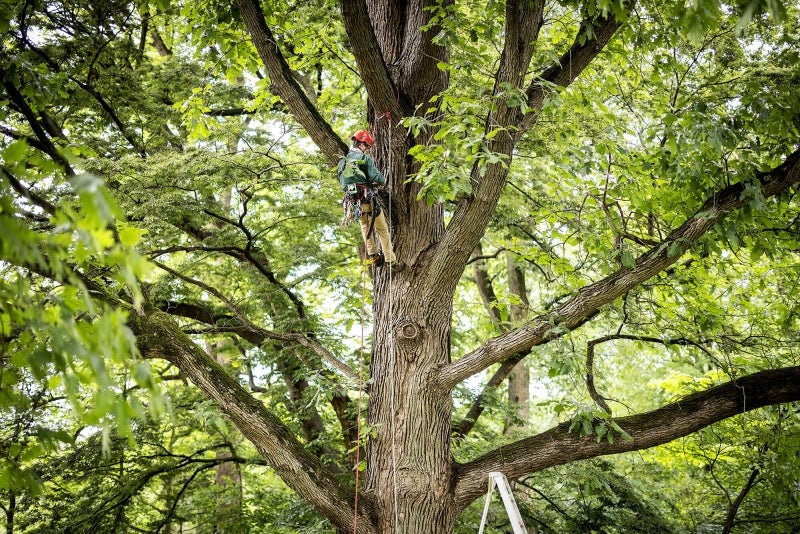Blog



The late actor John Candy once remarked that actors don’t get paid to act, they get paid to sit around and wait, and act for free because of their love of the craft.
The same applies to Peter Fixler and his work as lead arborist at the Morris Arboretum & Gardens. He says he gets paid to do administrative and management work and climbs the trees for free.
“I’m definitely the happiest when I’m climbing trees,” he says. “The physicality and the mental challenge of it is what I love.”
Hired by the Morris in 2020, Fixler aids in nurturing and maintaining the vast and diverse collection of more than 4,170 trees on the Morris’s property in Chestnut Hill. He says his No. 1 priority as an arborist is to make sure the trees are healthy and hazard-free.
“Most people don’t realize how much goes into keeping trees healthy and safe,” says Fixler. “We’re always assessing things like deadwood or root health—small issues that, if left unchecked, could eventually pose problems.”
Penn Today visited the Morris, the official arboretum of Pennsylvania, to chat with Fixler about his interest in tree work, how trees benefit the planet, the tallest tree he has climbed, current research at the Morris, and its impact in the region and beyond.
How did you become interested in tree work?
I graduated with a degree in biology and an interest in microbiology. I did work in some labs in my younger days and kind of went in and out of tree work. Eventually, I committed to it because I saw the potential to make a living. I think trees are the greatest medium because no other living organism grows larger or lives longer than a tree. I thought that was really cool.
Besides water and sunlight, what do trees need to stay healthy?
Trees don’t need much, really. They produce their own food. They basically need to be left alone. Trees in urban or suburban areas aren’t growing the way they would in a forest, so they need a bit of extra care. Pruning is especially important because they grow differently without the natural competition and structure of a woodland setting. As a result, they could develop some structural deficiencies that may need to be corrected at a young age or even an old age.

How do you service trees when they need to be treated or pruned?
There’s no getting around it: you have to climb them. We climb up there and make the pruning cuts and care for them that way.
What’s the tallest tree that you’ve climbed?
Probably a tulip popular. It’s probably 130 feet, at least.
Have you come across any unique animals while climbing atop a tree?
I’ve fended some squirrels off, talked to raccoons. One of my coolest experiences was when I saw a flying squirrel. We made eye contact and he was like, ‘I’m out of here!’ I had the bird’s-eye view and he just [makes flying sound] to the tree next to us. You don’t see that every day. I’ll never forget that one.
Your job sounds physically demanding. Is physical fitness a requirement?
Absolutely. Industrial athletes are what we’re called. Someone said that at a show, and I think it’s a good description because there’s no cheating this. You cannot enter this profession out of shape and do well, or you’re going to get hurt. There is a certain physicality required. Doing it every day will definitely keep you fit, but if you’re not going to do it every day, you should definitely do some gym work.
Obviously, trees provide the world with oxygen. What other benefits do they offer human beings and the planet?
The greatest benefit is carbon sequestration, so taking CO2 out of the air and out of the environment and storing it in their wood. That’s why the older trees here, the bigger trees here, are so valuable because a 100-year-old tree versus a 20-year-old tree is a hundredfold greater— just from the surface area alone—at trapping carbon in the environment. Maintaining those veteran trees is very important to try to keep the environment in check.
What is your definition of an ‘old tree’?
A tree definitely over 100 years old, which is a lot of trees here, because we have them catalogued. Trees have kind of a bell curve to their life. They grow rapidly, then they plateau, and then they kind of decline or start shrinking back into their roots. At over 300 years old, they get into ancient tree status where they’re an apex ecosystem habitat for their environment because they’ve been there so long. So many bugs and fungi and birds are depending on them that you want to maintain them.

Does the Morris have any trees that produce fruit?
We just planted an orchard of 25 different kinds of apple trees uphill from the community garden located on our property. We also have figs along our administrative offices in Gates Hall. We have some native persimmon and pawpaw trees; they produce fruit in the fall. And there are some Asian pears as well.
What is some of the current research being conducted by the experts at the Morris?
At the Morris right now, we are trying to figure out what the trees of the future are going to be. As our climate is shifting, we’re seeing trees that used to do well here not doing as well, and trees that barely did well here—because it was too cold—doing fine here. One research focus of the Morris is to collect trees from the Southeastern U.S. The live oak is an example. It was collected in Virginia and seems to be doing well here now. In the past, it didn’t thrive because our winters were too cold, but that’s starting to change. It’s an awful thing to see in real time—trees that you really love and cherish, like a sugar maple, unfortunately are one of the trees that aren’t doing as well in this warming environment.
Penn’s West Philadelphia campus has been accredited as an arboretum and has more than 6,500 trees. Can you talk about some of the work the Morris does on the main campus?
The arborist crew here supports the Morris’s Urban Forestry Consultants. Urban Forestry is a great representative of the Morris on campus. Mike Dunn, who’s the new head of that department, often consults with Penn’s Facilities and Real Estate Services (FRES) on how construction impacts trees on campus to see if specific tress can be preserved, or if they need to be removed. Penn does a great job of trying to preserve trees whenever possible. Morris’s Urban Forestry team and the Arborist team assess all 6,500 trees every year and enter their findings into a database for the FRES team to decide what tree work is to be done on campus. That’s really the best situation for anybody having tree work done: have an independent person assess the trees, and then you have information to tell the tree company what to do.
How does the work you do at the Morris impact the greater arboretum field, in the United States and beyond?
I’m always trying to get further educated to constantly update my knowledge. Our former executive director, Paul Meyer, and his wife, Debra Rodgers, set up an endowment to provide out-of-the-ordinary study travel scholarships for Morris staff. I knew coming into this job that I was going to have to deal with a lot of really old trees, and a place where there are a lot of really old trees is in England. Through the endowment, I visited 10 sites (four in the greater London area) in the span of eight days, meeting with their respective tree managers. I learned about what they do to care for their ancient trees. Their trees are really old over there; we’re talking 300- to 800-year-old trees. It was a perspective-changing trip. I came back with more questions than answers. I learned a whole new vernacular. The knowledge I obtained can be applied here in certain situations for our older trees. That knowledge gained has been presented to the public through the Morris’s classes. That’s an example of how we’re trying to lead through the Morris Arboretum & Gardens. That was a fantastic opportunity to see some amazing trees and meet some amazing tree people.